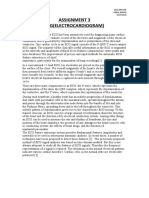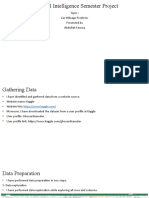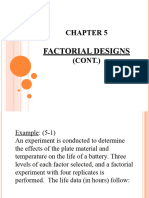0 ratings0% found this document useful (0 votes)
47 viewsAnova: Overall Conclusion: Yes, After Applying The Two Way ANOVA We Find That There Is A Difference in
A two-way ANOVA test determines the effect of two independent variables on a dependent variable. It tests for differences in the means of the dependent variable for all combinations of levels of the two independent variables as well as for interaction between the two variables. The document provides examples of two-way ANOVA analyses with different independent and dependent variables such as temperature and material type on battery life. It tests null hypotheses about no differences or interaction and reports p-values to determine whether to reject the null hypotheses.
Uploaded by
Muhammad WajahatCopyright
© © All Rights Reserved
Available Formats
Download as DOCX, PDF, TXT or read online on Scribd
0 ratings0% found this document useful (0 votes)
47 viewsAnova: Overall Conclusion: Yes, After Applying The Two Way ANOVA We Find That There Is A Difference in
A two-way ANOVA test determines the effect of two independent variables on a dependent variable. It tests for differences in the means of the dependent variable for all combinations of levels of the two independent variables as well as for interaction between the two variables. The document provides examples of two-way ANOVA analyses with different independent and dependent variables such as temperature and material type on battery life. It tests null hypotheses about no differences or interaction and reports p-values to determine whether to reject the null hypotheses.
Uploaded by
Muhammad WajahatCopyright
© © All Rights Reserved
Available Formats
Download as DOCX, PDF, TXT or read online on Scribd
You are on page 1/ 3
LAB#15
Two Way ANOVA
A two-way ANOVA test is a statistical test used to determine the effect of two nominal
predictor variables on a continuous outcome variable. ANOVA stands for analysis of variance and tests
for differences in the effects of independent variables on a dependent variable.
ANSWER OF QNO 1
1) H0 →μ72= μ72= μ73 H02→μm1=μm2 =μm3 Ho3→Interaction b/w temperature &material type isn’t
HO1→μ71≠μ72≠μ73, Ha2→μm1≠ μm2≠ μm3, Ha3→Interaction b/w temperature &material type is
2) As α is not given ,we will assume it 5%
3) Determination of p-value
4) If p<α, Ho , If p>α, reject HA
Case #1(Temperature, Battery life):
P-value =0
As P<α, Ho1 will be rejected
Conclusion:
At the assumed significance level (α) of 5% , data provide sufficient evidence to conclude that
the mean battery
Life change due to the change in temperature
Case #2(Material type ,Battery life)
P-value=0.002
As P<α, Ho2 will be rejected
Conclusion:
At the assume significance level (α) of 5% data provide sufficient evidence to conclude that the
mean battery
Life changes due to the change in material type
Case#3 (Material type , temperature ,Battery life)
P-value=0.019
As P<α ,Ho2 will be rejected
Conclusion:
At the assumed significance level (α) of 5% , data provide sufficient evidence to conclude that
the mean battery
Life change due to the change in both the material type & temperature
Overall Conclusion: Yes , after applying the two way ANOVA we find that there is a difference in
the mean life of batteries by varying the temperature and changing the type of material.
ANSWER OF Q 2
1) H0 →μ72= μ72= μ73 H02→μm1=μm2 =μm3 Ho3→Interaction b/w Center &Dose Group isn’t
HO1→μ71≠μ72≠μ73, Ha2→μm1≠ μm2≠ μm3, Ha3→Interaction b/w Center &Dose Group is
2) As α is not given ,we will assume it 5%
3) Determination of p-value
4) If p<α, Ho , If p>α, reject HA
Case #1(Center, Dose group):
P-value =0
As P<α, Ho1 will be rejected
Conclusion:
At the assumed significance level (α) of 5% , data provide sufficient evidence to conclude that
the mean dose group
Life change due to the change in temperature
Case #2(Center, Dose)
P-value=0.038
As P<α, Ho2 will be rejected
Conclusion:
At the assume significance level (α) of 5% data provide sufficient evidence to conclude that the
mean battery
Life changes due to the change in material type
Case#3 (Material type , temperature ,Battery life)
P-value=0.049
As P<α ,Ho2 will be rejected
Conclusion:
At the assumed significance level (α) of 5% , data provide sufficient evidence to conclude that
the mean hemoglobin
Life change due to the change in both the center type & dose
Overall Conclusion: Yes , after applying the two way ANOVA we find that there is a effect on the
hemoglobin if it is tasted individually with the center and the doses of rebligen but as it is tested
with both center and doses of rebligen altogether the hemoglobin is not effected .
ANSWER Q3
1) H0 →μ72= μ72= μ73 H02→μm1=μm2 =μm3 Ho3→Interaction b/w Center &Dose Group isn’t
HO1→μ71≠μ72≠μ73, Ha2→μm1≠ μm2≠ μm3, Ha3→Interaction b/w Center &Dose Group is
2) As α is not given ,we will assume it 5%
3) Determination of p-value
4) If p<α, Ho , If p>α, reject HA
Case #1(Cancer, Doses):
P-value =0
As P<α, Ho1 will be rejected
Conclusion:
At the assumed significance level (α) of 5% , data provide sufficient evidence to conclude that
the mean dose group
Life change due to the change in cancer
Case #2(Cancer, Doses)
P-value=0.038
As P<α, Ho2 will be rejected
Conclusion:
At the assume significance level (α) of 5% data provide sufficient evidence to conclude that the
mean battery
Life changes due to the change in material type
Case#3 (Hemoglobin, cancer, Doses)
P-value=0.049
As P<α ,Ho2 will be rejected
Conclusion:
At the assumed significance level (α) of 5% , data provide sufficient evidence to conclude that
the mean hemoglobin
Life change due to the change in both the cancer type & doses
Overall Conclusion: Yes , after applying the two way ANOVA we find that there is a effect on the
hemoglobin if it is tasted individually with the center and the doses of rebligen but as it is tested
with both cancer and doses of rebligen altogether the hemoglobin is not effected .
You might also like
- Inferensi Disekitar Mean Dan Pos Hoc-ZahroNo ratings yetInferensi Disekitar Mean Dan Pos Hoc-Zahro11 pages
- 14.1 An Experiment Was Conducted To Study The Effects of Temperature and Type of OvenNo ratings yet14.1 An Experiment Was Conducted To Study The Effects of Temperature and Type of Oven9 pages
- One Way and Two Way Classification Analysis of Variance - P10A, P10B, P11A, P11B, P12A, P12BNo ratings yetOne Way and Two Way Classification Analysis of Variance - P10A, P10B, P11A, P11B, P12A, P12B77 pages
- Statistical Analysis 8: Two-Way Analysis of Variance (ANOVA)No ratings yetStatistical Analysis 8: Two-Way Analysis of Variance (ANOVA)4 pages
- Two Mean T Test Asuuming Equal VariancesNo ratings yetTwo Mean T Test Asuuming Equal Variances8 pages
- Stat Zttestsexer Two SampleTests ExSW StudNo ratings yetStat Zttestsexer Two SampleTests ExSW Stud3 pages
- A319 - 8 - Individual File Submission - 20007322 - 001No ratings yetA319 - 8 - Individual File Submission - 20007322 - 0017 pages
- Students t-test for the analysis of biomedical dataNo ratings yetStudents t-test for the analysis of biomedical data15 pages
- Tutorial: CTM 2019 Probability and Statistics For Data SciencesNo ratings yetTutorial: CTM 2019 Probability and Statistics For Data Sciences15 pages
- Winter 2017 BE 2100 Exam 3 Thursday SolutionNo ratings yetWinter 2017 BE 2100 Exam 3 Thursday Solution6 pages
- Assignment_Hypothesis Testing (Part 2) CopyNo ratings yetAssignment_Hypothesis Testing (Part 2) Copy5 pages
- ۔ماہنامہ الہلال۔۔شعبان المعظم 1442ھ PDFNo ratings yet۔ماہنامہ الہلال۔۔شعبان المعظم 1442ھ PDF95 pages
- Engineering Data Analysis Handsout Module 1 6 - CompressNo ratings yetEngineering Data Analysis Handsout Module 1 6 - Compress12 pages
- Neural Correlates of Learning Accommodation and Consolidation in Generalised Anxiety DisorderNo ratings yetNeural Correlates of Learning Accommodation and Consolidation in Generalised Anxiety Disorder8 pages
- Chapter No. 08 Fundamental Sampling Distributions and Data Descriptions - 02 (Presentation)No ratings yetChapter No. 08 Fundamental Sampling Distributions and Data Descriptions - 02 (Presentation)91 pages
- Artificial Intelligence Semester Project: Topic: Car Mileage Predictor Presented by Abdullah FarooqNo ratings yetArtificial Intelligence Semester Project: Topic: Car Mileage Predictor Presented by Abdullah Farooq17 pages
- 202003271457478511akash HeteroscedasticityNo ratings yet202003271457478511akash Heteroscedasticity16 pages
- Instant download Linear model methodology 1st Edition Andre I. Khuri pdf all chapter100% (8)Instant download Linear model methodology 1st Edition Andre I. Khuri pdf all chapter67 pages
- Jurnal Ekonomi Bisnis Dan Akuntansi: Mellasanti Ayuwardani Administrasi Binis,, Politeknik Negeri SemarangNo ratings yetJurnal Ekonomi Bisnis Dan Akuntansi: Mellasanti Ayuwardani Administrasi Binis,, Politeknik Negeri Semarang12 pages
- Penurunan Kadar Sianida Limbah Cair Industri Tapioka Dengan Larutan Kapur Tohor (Ca (Oh) ) Di Desa Ngemplak Kidul, Margoyoso, PatiNo ratings yetPenurunan Kadar Sianida Limbah Cair Industri Tapioka Dengan Larutan Kapur Tohor (Ca (Oh) ) Di Desa Ngemplak Kidul, Margoyoso, Pati10 pages
- Final Credit Risk Prediction Report CorrectedNo ratings yetFinal Credit Risk Prediction Report Corrected19 pages
- Interpreting epidemiologic evidence: connecting research to applications Second Edition Savitz - Download the ebook now for the best reading experience100% (2)Interpreting epidemiologic evidence: connecting research to applications Second Edition Savitz - Download the ebook now for the best reading experience68 pages
- The Percentage Oil Content, P, and The Weight, W Milligrams, of Each of 10 RandomlyNo ratings yetThe Percentage Oil Content, P, and The Weight, W Milligrams, of Each of 10 Randomly17 pages





























































































